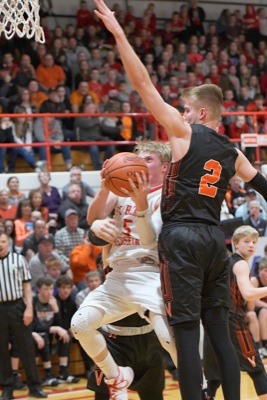Saturday, February 10th, 2018
Digging history
Expansion site dig finds no artifacts
By William Kincaid

Submitted Photo
Trey Hill, a Ball State University graduate and a current Illinois State University graduate student, on Dec. 22 digs while conducting an archaeological study of Wendel Poultry Service Inc. in Fort Recovery.
FORT RECOVERY - Christine Thompson, a village native and Ball State University archaeologist, on Dec. 22 led a trio of college students as they swept metal detectors over the site of Wendel Poultry Service Inc.'s proposed expansion.
Since Wendel is seeking county revolving loan funds, seeded by federal dollars, owners had to complete an archaeological review of the property at 1860 Union City Road due to its proximity to historical battlefields where early U.S. soldiers battled a confederation of Native Americans.
County officials, though, didn't look far for the ideal candidate to lead the review, county community development director Jared Ebbing said. Fort Recovery Village Administrator Randy Diller directed them to Thompson.
Thompson and the university's applied anthropology laboratories since 2009 have collaborated with state and village officials and local landowners to research, preserve and raise awareness of the sites of the 1791 Battle of the Wabash and the 1794 Battle of Fort Recovery. The university's applied anthropology laboratories in 2015 received Ohio History Connection's Public Education and Awareness award "for increasing public awareness in the preservation and protection of the battlefield at Fort Recovery."
Thompson during a meeting with county commissioner Greg Homan this week said such a study is required when federal dollars are used for earth-moving projects on historical properties so archaeological sites aren't accidentally destroyed. The county contracted with Ball State University for the $3,000 study paid with local revolving loan funds.
Ebbing initially fretted upon learning of the Ohio History Connection-required site review but said his fears of a drawn-out process were soon allayed. The study was completed less than a month after contacting university officials.
No battlefield artifacts were unearthed, paving the way for Wendel Poultry, a provider of poultry vaccinating, beak trimming and transportation services to proceed with plans to build a truck wash.
"The good news is we've been able to actually work with somebody here local and get done pretty easily," Ebbing said.
The study on Dec. 22 took most of the day, as the trio of undergraduate and graduate students scoured the site for artifacts.
"We just did a metal detector sweep of every 15 feet," Thompson said. "When we hit something they would dig it up."
Though no battlefield relics were found, the students did turn up pop cans, a skeleton key, a debeaker and assorted parts from a washing system.
Thompson pointed out that previous surveys of the local battlefield yielded discoveries of lead balls, musket parts and other historically significant objects.
Ebbing stressed that he doesn't want to see potential revolving loan applicants spooked away at the idea of undertaking such a study.
"It's not like an everyday occurrence," he said.
In this case, the study was essentially a piece of cake.
"It hasn't really hurt us in any way, shape or form," he said. "It was a pretty streamlined process. Whenever things have to be done, we get through it pretty quick."
In the eight years of leading the community development office, Ebbing said he's had to complete only three archaeological studies - the proposed Wendel Poultry expansion, the extension of Albers Road to accommodate Ferguson Enterprises pipeyard operation and Mercer Landmark's proposed expansion near St. Henry.
"Fort Recovery is probably a special case in Mercer County because it's a battlefield that a town was built on top of," Thompson said.
The town now known as Fort Recovery was the site of two major battles vital to the nation's westward expansion. The village itself was incorporated in 1858.
U.S. Gen. Arthur St. Clair in 1791 was tasked with waging a campaign as part of the Northwest Indian Wars, Thompson told Homan.
"He was actually building a series of forts from Fort Washington, which is Cincinnati, up to Kekionga, which is Fort Wayne," Thompson said of the convoy of about 1,200 soldiers and a couple hundred camp followers.
"His men, their last fort they had built was at Fort Jefferson, which is down by Greenville and (U.S.) 127 and then they marched up over a series of six days, and they camped at the banks of the Wabash River," she continued. "They actually thought they were closer to Fort Wayne so they didn't really know where they were."
A similar-sized confederation of nine native tribes, made up mostly of Miami, Shawnee and Delaware warriors, struck a decisive win that fateful day. They first targeted officers and in the ensuing chaos inflicting 600 casualties and wiping out all 300 camp followers.
"That battle was a complete victory for Native Americans. It started at dawn on Nov. 4," she said. "It lasted about three hours, and it totally decimated St. Clair's army."
In the aftermath, survivors fled back to Fort Jefferson. Wendel Poultry lies about a mile south of where the soldiers may have made their desperate retreat, Thompson pointed out.
St. Clair, later relieved of his duties, was replaced by Gen. Anthony Wayne in 1792.
He was the polar opposite of St. Clair, training his army for a year or two before returning to the site of the bloodbath and burying the remains of the fallen and constructing Fort Recovery.
The tide turned for Americans in 1794 with the Battle of Fort Recovery when the U.S. Army defeated the largest Native American force ever assembled.
As part of their work, funded by a combination of National Park Service American Battlefield Protection Program grants and Ball State grants and matching funds, the laboratory students and staff over the years delineated more clearly and accurately the boundaries of the battlefield with a metal detector, magnetometer and resistivity surveys and a field school. The research found the battlefields cover more than 630 acres.
"The more people know, the more they appreciate it, and the more they want to preserve it," Thompson said about the battlefields.




